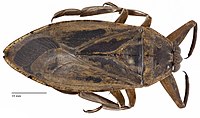
Classical biological control of invasive stink bugs with egg parasitoids - what does success look like?
Sign Up to like & getrecommendations! Published in 2020 at "Pest management science"
DOI: 10.1002/ps.5813
Abstract: Although the enemy release hypothesis forms the theoretical basis for classical (=importation) biological control of invasive pests, its core assumptions are not always examined. This could contribute to unrealistic expectations for some biological control programs.… read more here.
Keywords: control invasive; invasive stink; control; egg parasitoids ... See more keywords

Comparative morphology of the odoriferous system in three predatory stink bugs (Heteroptera: Asopinae)
Sign Up to like & getrecommendations! Published in 2017 at "Protoplasma"
DOI: 10.1007/s00709-017-1087-y
Abstract: The metathoracic scent system in Heteroptera produces and releases defensive volatile compounds. The odor produced by predatory stink bugs differs from phytophagous bugs, suggesting a variation between the structure and function of the metathoracic scent… read more here.
Keywords: system; scent; odoriferous system; stink bugs ... See more keywords

A novel trophobiotic interaction between a Neotropical stink bug and an ant species: Insights into potential benefits to the host plant
Sign Up to like & getrecommendations! Published in 2021 at "Behavioural Processes"
DOI: 10.1016/j.beproc.2020.104296
Abstract: Trophobiotic interactions occur when phytophagous insects provide a sugary liquid, the honeydew, for ants and obtain defence against predators or parasitoids. The plants may indirectly benefit from an increased ant foraging activity by reducing the… read more here.
Keywords: trophobiotic interaction; plant; stink bugs; interaction ... See more keywords

Integrating environmental variables and geospatial technologies in landscape scale habitat modelling of edible stink bugs in Zimbabwe
Sign Up to like & getrecommendations! Published in 2018 at "Physics and Chemistry of The Earth"
DOI: 10.1016/j.pce.2018.01.002
Abstract: Abstract Encosternum delegorguei spinola (edible stink bugs) is renowned for its high protein and contribution to the local economies of the people in Africa. Although many studies have evaluated the economic and nutritional importance of… read more here.
Keywords: habitat; edible stink; integrating environmental; stink bugs ... See more keywords

Olfactory responses of Trissolcus mitsukurii to plants attacked by target and non-target stink bugs suggest low risk for biological control
Sign Up to like & getrecommendations! Published in 2022 at "Scientific Reports"
DOI: 10.1038/s41598-022-05873-w
Abstract: In crop systems, successful management of invasive insect herbivores can be achieved through the introduction of exotic biocontrol agents, parasitoids or predators, having a coevolutionary history with the pest. To avert threats to local biodiversity,… read more here.
Keywords: trissolcus mitsukurii; non target; stink bugs; target ... See more keywords

Strong functional integration among multiple parts of the complex male and female genitalia of stink bugs
Sign Up to like & getrecommendations! Published in 2017 at "Biological Journal of The Linnean Society"
DOI: 10.1093/biolinnean/blx095
Abstract: Genitalia are among the most studied phenotypes because they exhibit high anatomical diversity, experience fast evolutionary rates and may be shaped by several evolutionary mechanisms. A key element to uncover the mechanisms behind such impressive… read more here.
Keywords: diversity; male female; female genitalia; strong functional ... See more keywords

Assessment of Toxicity Risk of Selected Insecticides Used in Pistachio Ecosystem on Two Egg Parasitoids (Hymenoptera: Scelionidae) of Stink Bugs (Hemiptera: Pentatomidae)
Sign Up to like & getrecommendations! Published in 2021 at "Journal of Economic Entomology"
DOI: 10.1093/jee/toab129
Abstract: Abstract Psix saccharicola (Mani) and Trissolcus semistriatus (Nees) are the most abundant eggs parasitoids of the stink bug, Acrosternum arabicum Wagner, in pistachio orchards and have the potential to contribute to their suppression. However, treatment… read more here.
Keywords: used pistachio; risk; egg parasitoids; toxicity ... See more keywords

Intra- and Interspecific Variation in the Susceptibility to Insecticides of Stink Bugs (Hemiptera: Pentatomidae) That Attack Soybean and Maize in Southern Brazil
Sign Up to like & getrecommendations! Published in 2022 at "Journal of Economic Entomology"
DOI: 10.1093/jee/toac013
Abstract: Abstract This study evaluated intra- and interspecific variation regarding the susceptibility to insecticides of key pentatomid pests of soybean (Glycine max L.) and maize (Zea mays L.) crops in Brazil. To perform bioassays, populations of… read more here.
Keywords: bifenthrin; intra interspecific; susceptibility; susceptibility insecticides ... See more keywords

Spatiotemporal Distribution of Two Euschistus spp. Stink Bugs (Hemiptera: Pentatomidae) in Southeastern Farmscapes.
Sign Up to like & getrecommendations! Published in 2022 at "Journal of insect science"
DOI: 10.1093/jisesa/ieab111
Abstract: Stink bugs (Hemiptera: Pentatomidae) are ubiquitous, cryptic, phytophagous pests that are found in many crops. In agroecosystems, individuals disperse from adjacent noncrop hosts and tend to aggregate or cluster within fields. In this study, we… read more here.
Keywords: spatiotemporal distribution; euschistus; hemiptera pentatomidae; stink bugs ... See more keywords

Predation on stink bugs (Hemiptera: Pentatomidae) in cotton and soybean agroecosystems
Sign Up to like & getrecommendations! Published in 2019 at "PLoS ONE"
DOI: 10.1371/journal.pone.0214325
Abstract: Stink bugs (Hemiptera: Pentatomidae) are significant pests of cotton and soybeans in the southeastern United States with annual control costs exceeding $14 million in these crops. Three of the most prominent stink bug pests are… read more here.
Keywords: bugs hemiptera; hemiptera pentatomidae; stink bugs; stink ... See more keywords

Invasive Stink Bugs and Related Species (Pentatomoidea). Biology, Higher Systematics, Semiochemistry, and Management.
Sign Up to like & getrecommendations! Published in 2018 at "Florida Entomologist"
DOI: 10.1653/024.101.0235
Abstract: McPherson JE [Ed.]. 2018. Invasive Stink Bugs and Related Species (Pentatomoidea). Biology, Higher Systematics, Semiochemistry, and Management. CRC Press, Boca Raton, FL. 819 pp. ISBN 9781498715089 $149.95 (hardcover). View this article in BioOne read more here.
Keywords: invasive stink; biology; stink bugs; bugs related ... See more keywords